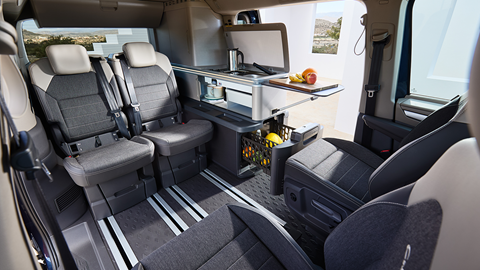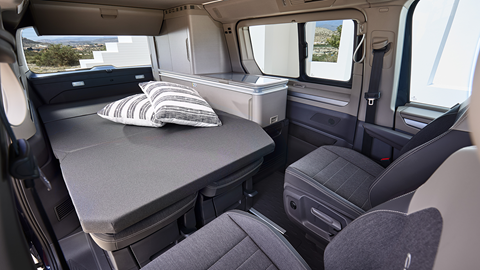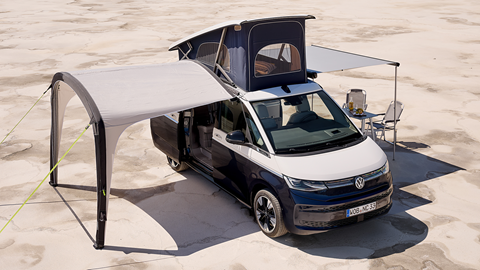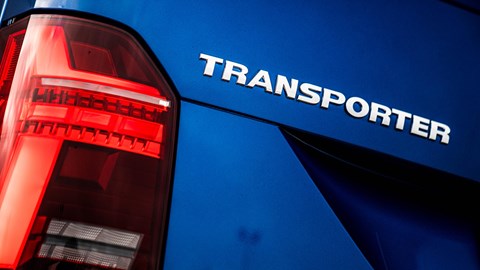► Next-generation VW California
► Based on car-like Multivan
► Comes with more doors, PHEV power
Right, you’ve had your Mamas and Papas reference – on to the important stuff. You’re looking at the all-new Volkswagen California campervan, now available as a plug-in hybrid and with all-wheel drive.
Yep, as teased with last year’s concept model, you can now spec your California with a 243bhp hybrid electric power unit, but there’s plenty more to discuss here than just the engine. The new California has been comprehensively redesigned, according to Volkswagen, as it’s shifted onto VW’s MQB platform.
Not only that, but the interior has been overhauled and new recreational features have been introduced as part of the package. Oh, and there’s now a sliding door on both sides of the vehicle.
Read for everything you need to know about the new Volkswagen California.
More doors for…?
Better access, obviously. This will likely be of particular interest to UK buyers, as all previous Californias have their sliding door on the right only. This isn’t ideal for letting people out safely as you’ll usually find out pavements on the left.

According to Lars Krause from the Commercial Vehicles Sales and Marketing team, adding an extra sliding door was a priority for the convenience and safety of VW’s UK and New Zealand-based customers – it was from that idea that the new ‘three living spaces’ design concept was conceived, with awnings or tents on either side.
As ever, there’s a flat floor throughout as well, so moving between the front and rear seats – also known as the lounge and kitchen area – remains easy. In fact, it’s now even better, as the Multivan uses an electronic handbrake instead of the trouser-grabbing lever.
Wait. Where’s the kitchen?
Roughly where it’s always been, on the left side of the cabin. Except now that there’s a door on that side VW’s had to be even cleverer about its design.
So instead of a fixed amount of kitchen real estate, the California features a slide-out work surface that integrates an induction hob, gas hob and sink. Below this you’ll find storage, including drawers that can be accessed inside and outside the vehicle, and a similarly versatile fridge.

The change here means you can access the cooking and cold storage facilities from outside of the van as well. To encourage this kind of alfresco adventurousness, Volkswagen has also integrated a portable electric grill into the concept and fitted the main awning on this side.
You can still enjoy some protection from the elements on the right, however, as the new California comes with a sun sail on that side. It’s like a complete mobile camp site or something, especially as VW has still found room for the traditional outdoor table (this doubles as the indoor table and stores under the lower bed) and chairs that store in the tailgate. These have higher backrests than before for extra comfort.
When the T7 California reaches production, buyers will be able to chose which side they want the full awning attached, or even have one on both.
What about sleeping and sitting?
As with previous Californias there’s a pop-up roof, shelled here in aluminium and featuring more panoramic windows than previously considered. Up top you’ll find a sprung bed base, LED lighting and USB-C sockets. Very civilised.
Downstairs a second bed can be created using the rear seat backs and a mattress. For the first time, these rear seats are also individual chairs, making them easier to remove than the old – heavy – bench. They also enhance practicality in other ways, as you could just take out just one or install them in parallel so you can slide in a mountain bike or something.

In addition to the obvious cupboards there’s storage in the base of these and the front seats, which swivel to face the rear in order to create more of a lounge when you’re parked.
And before you ask about something else that sounds a bit like ‘sitting’, there’s no bathroom aboard this new California. You’ll still need the Grand California for that. But because the Multivan base vehicle is longer than the Transporter, VW reckons you could get a composting toilet in behind the front seats. If you really wanted to.
There is an outdoor shower, though, should you fancy that.
Can I use the hybrid battery to power my camper’s systems?
No. The team behind the new California explained to us that the idea was considered but wasn’t pursued as doing so could compromise the usability of the car.
‘During conceptual development we always said it would be better to separate the two electric systems,’ Krause told CAR.
‘It’s a matter of the durability of the vehicle and it being ready to use. When you get to your campsite, the electric systems for all camper functions will be ready. No compromises on that, it needs to be useable at all times.’
This means campsites with proper electricity hook-ups will still be favoured. But if this isn’t available you’ll still be able to use the gas hob to heat your beans. VW is hoping to bring this degree of practicality to production, but it will come at a cost.
How far will the plug-in hybrid California go on electricity alone?
We’d initially suspected not as far as a regular Multivan’s circa 30 miles, due to the additional weight of the camper conversion. However, speaking to VW at the reveal event it confirms the same range electric-only range is expected from the California, as the extra weight of the conversion is offset by the reduced number of passenger seats.
Either way, Volkswagen is probably right in pointing out that the new California represents a useful halfway house between the previous diesel-only Californias and the all-electric ID. California that’s also due in the next couple of years.

We expect customers will have variable thoughts about the turbo-petrol engine that exists alongside the electric components in the T7 California.
Is that a tablet computer on the wall?
Literally an iPad. It’s mounted on an extendable arm and running the new control software for the California’s camping functions – including the powered roof. It’s an evolution of the system already offered in the Grand California and folds into the wall just above the sink area.
The new California can also be controlled via your smartphone. There’s a backup set of controls in the infotainment system as well.
When does the new California go on sale?
No exact date yet, but VW is promising it will be available to buy in 2024.
Which is when Ford is saying the next-generation Nugget will be available with it’s own plug-in hybrid powertrain.
How much will it cost?
Official prices haven’t yet been revealed, but we expect starting figures will likely eclipse those of the outgoing generation, so north of £60,000 for a base-spec Beach model. We think the official numbers will be released by late summer, so stay tuned.
Will there be an all-electric California?
Krause told us that VW is working on an all-electric California concept, though based on the ID. Buzz rather than the Multivan chassis. However, he admitted that an all-electric campervan like the California is a concept rife with flaws and issues.
‘I think that there are lots of compromises,’ Krause said.
‘One is range, the second compromise is on weight as batteries are heavy and the third compromise is on speed.’
Pointing to the scintillating Ocean spec California under the spotlights, he explained that the ICE power units on offer in the new California range are where VW’s current customer demands lie.
‘I think there could be a demand (for an electric California), but at this current stage, it’s very small.’
What does this mean for the Volkswagen Transporter van?
Good question. As mentioned above, the Volkswagen California has been a van underneath its posh skin up until the outgoing generation, and the switch to the Multivan is a promising one on several fronts.
The decision to switch to using the Multivan, and therefore VW’s MQB platform, is not just to make the California a little posher and nicer to drive, though.
While we don’t know loads about the next generation of VW Transporter just yet, we do know that it is also facing a fundamental shift of its own. It will no longer be a pure VW product, as it is the latest vehicle to be developed courtesy of the partnership with Ford, dubbed Project Cyclone.
This agreement will see Ford and VW collaborate on several crucial commercial vehicle projects, some of which are already on sale – the new Ford Ranger and Volkswagen Amarok pickups are both fundamentally the same trucks underneath.

The Ford Transit Custom and Volkswagen Transporter are to be the next vehicles to come out of this partnership, with both due on sale in 2024. Ford is set to be the lead partner in this particular project, as it was with the Ranger. With the pickups, this meant that many of the major components – the engines, gearboxes and infotainment setup – are all Ford’s. Volkswagen was able to make changes to configurations and the external design, but it is very much the second partner.
So while VW hasn’t officially announced details of the next Transporter, Ford has told us plenty about the new Transit Custom. This means we can make an educated guess at what the Transporter will be like.
In short, it’ll come with some or all of Ford’s 108bhp, 134bhp, 148bhp and 168bhp 2.0-litre diesel engines, an electric version and possibly a plug-in hybrid. It’ll have some clever touches like a flat cabin floor, and potentially a staggered bulkhead to make the most of the loading bay.
This means that the VW Commercial Vehicle range will take on a slightly odd appearance. The small VW Caddy is of its own creation and based on the MQB platform. The Ford Transit Connect will be a rebadged version of this vehicle.
The innovative and all-electric ID. Buzz Cargo is based on VW’s EV-only MEB platform, and there is no Ford version of this. The Amarok is a Ford Ranger underneath, while the large VW Crafter is a purpose-built VW platform.
In short, the five VW vans and pickups share little with one another, which is a real rarity in this day and age.